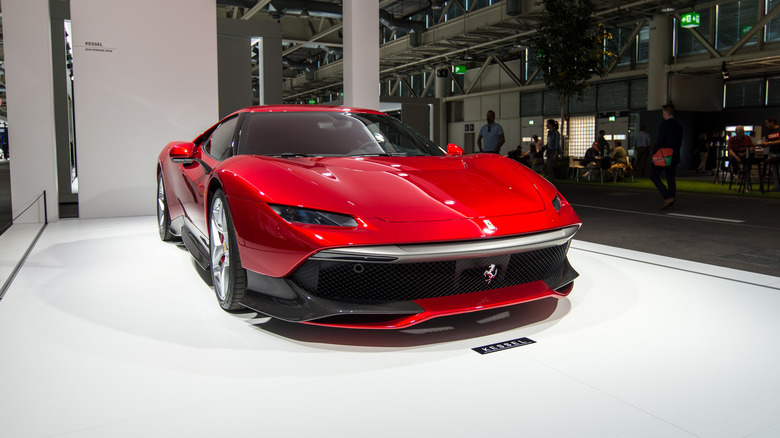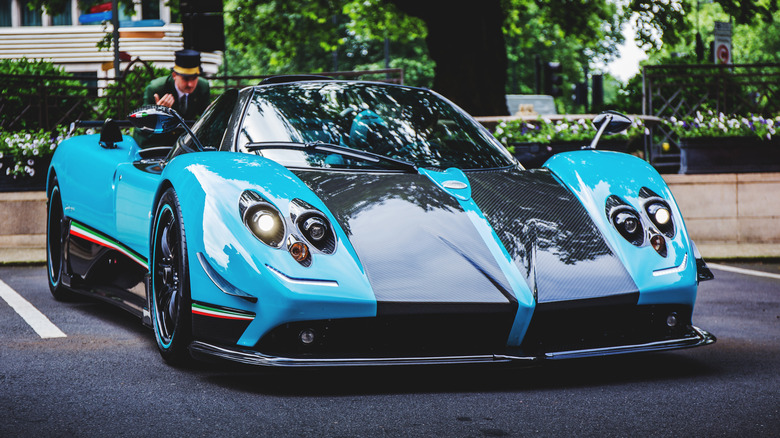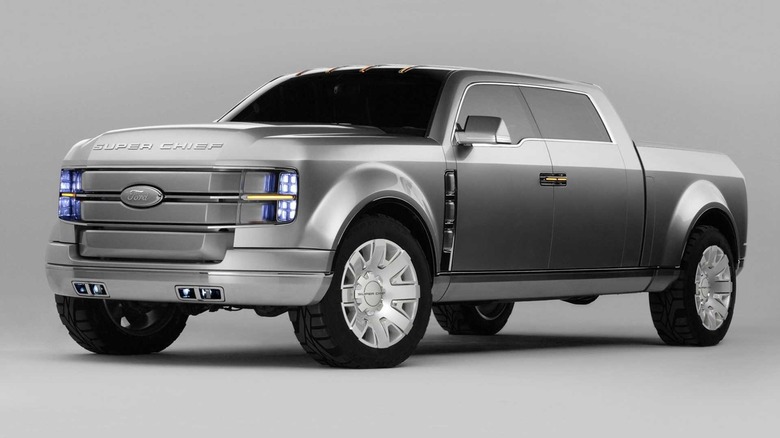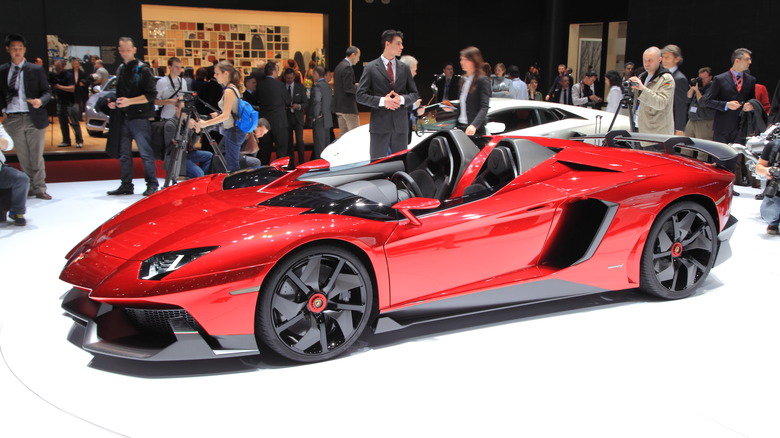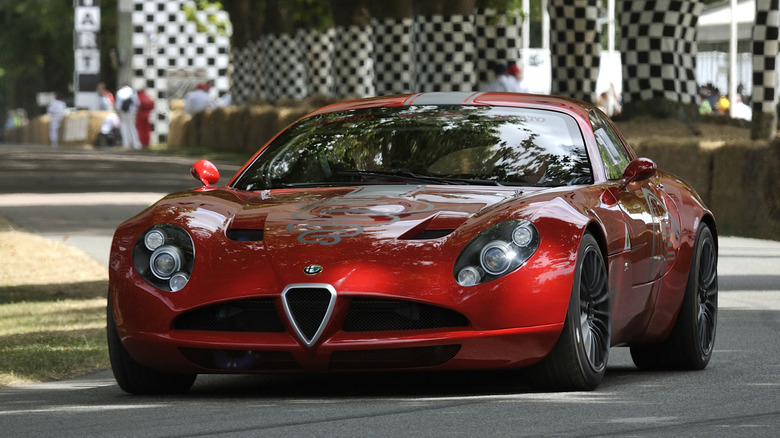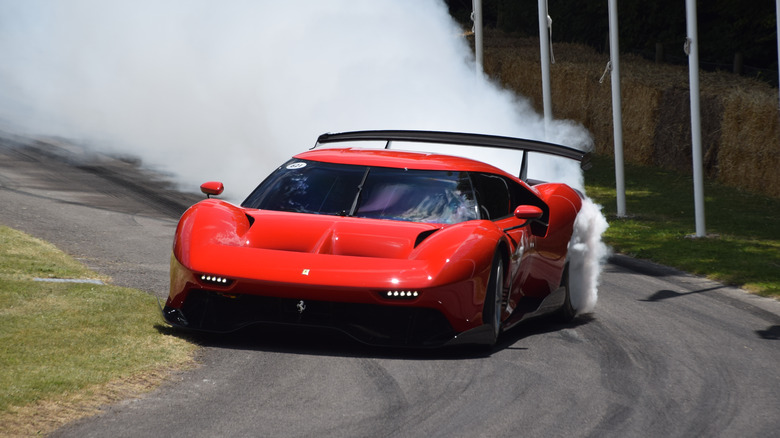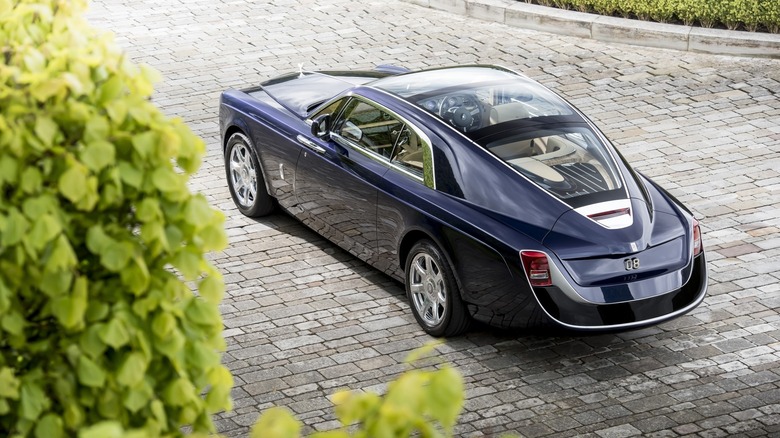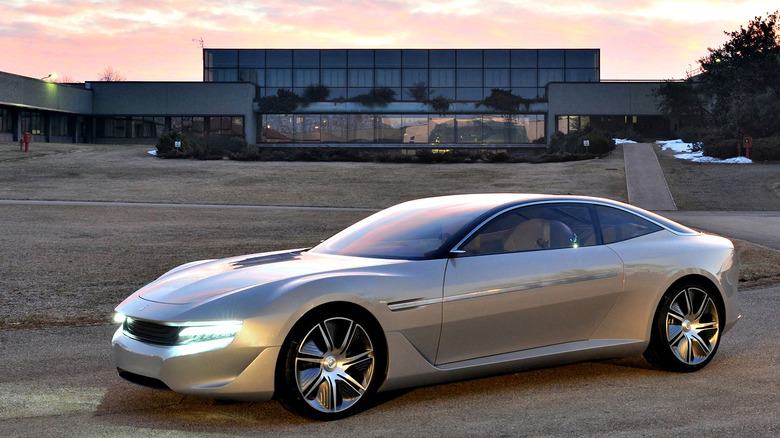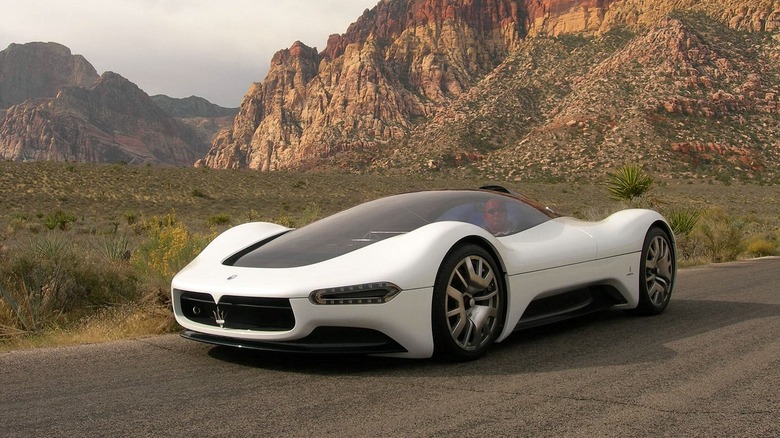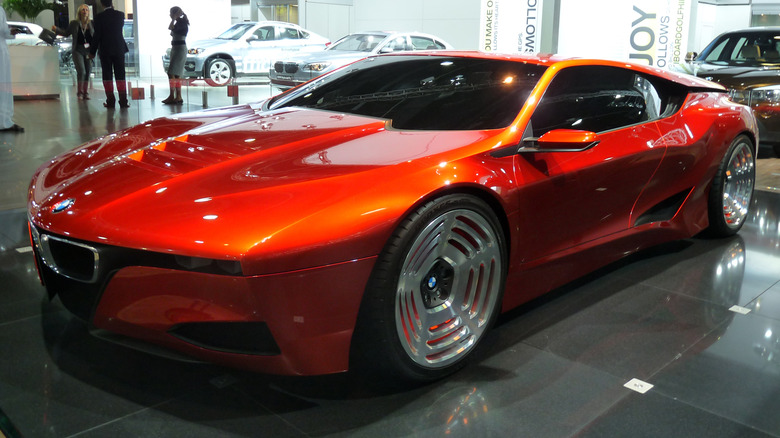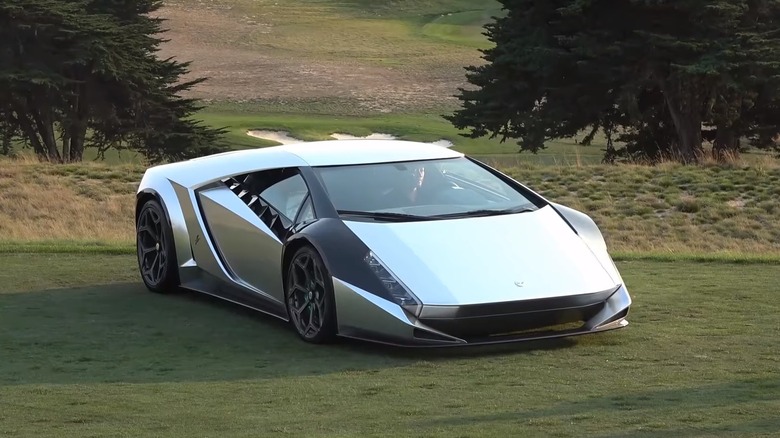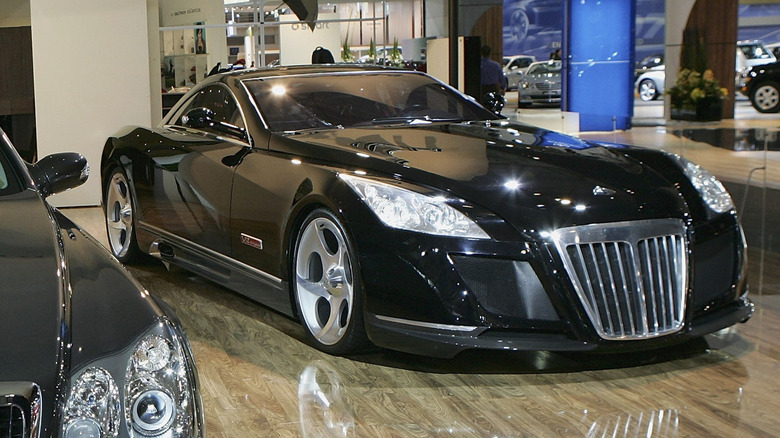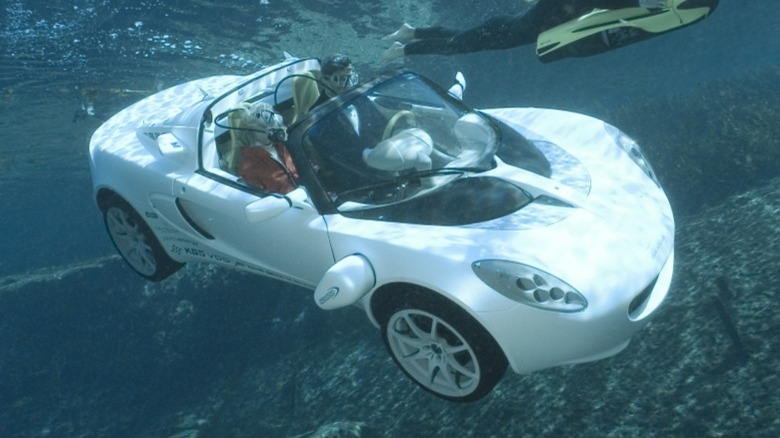Cars That Are So Rare Only One Of Them Exists
In the supercar and hypercar world, it's very difficult to stand out. A regular Ferrari, Lamborghini, or McLaren won't cut it for the most discerning collectors, who will already own a garage full of similar cars. These collectors desire something even rarer, specifically, something that no one else is lucky enough to own. To find that one-of-a-kind crown jewel for their collection, they have two options: either try to get their hands on a one-off creation like a concept car or prototype — or convince a manufacturer to build them their own unique creation that's exactly to their tastes.
Often, these one-off specials are incredibly expensive to purchase, costing their owners millions of dollars, but they're arguably all worth their asking price. After all, many collectors prioritize exclusivity over all else, and it doesn't get much more exclusive than having a car that no one else on the planet has the privilege of owning.
Of course, not every one-off is sold to a private collector. Manufacturers often keep their concepts, prototypes, and testing vehicles within their own collections, sometimes exhibiting them at museums, but more often than not, hiding them away in storage where only a handful of employees are allowed to view them. Whether they're hidden away in a collector's garage or in a manufacturer's storage facility, these cars are all so rare that most of us will probably never get to see them in the flesh.
Ferrari SP38 Deborah
Ferrari is notorious for being picky over who gets to buy its most exclusive cars, and there's a strict set of rules that owners should follow if they want to get access to the brand's VIP club. For their most loyal buyers, Ferrari launched a "Special Projects" program in 2007, which lets collectors work directly with the company's design team to create a truly one-off car. The SP38 Deborah is one of the program's most high-profile products, as it debuted in 2018 at the Concorso d'Eleganza Villa d'Este and toured several shows and exhibits before being handed to its new owner.
The SP38 Deborah was based on the 488 GTB and used the donor car's stock powertrain and internals. Its exterior, however, was fully remodeled, with a custom design that took inspiration from the classic F40. The car's unique shade of red paint was christened "Deborah Red," and it's the only Ferrari to ever be painted this color.
Pagani Zonda Uno
Unveiled in 2010, the Pagani Zonda Uno was supposed to be a final send-off for the Zonda model. It was commissioned by a member of the Qatari Royal family, who also owns a large collection of other cars in the same shade of turquoise blue, according to Motor1. The Zonda Uno used the same AMG-sourced 7.3L V12 engine present in the "regular" Zonda, which was capable of sending 690 horsepower to the rear wheels. The Uno's unique bodywork was reportedly inspired by the Zonda Cinque and the track-only Zonda R, which themselves were both incredibly rare, with only 10 units and 16 units produced, respectively.
The Qatari Royal family quickly got bored with their new toy, listing it for sale just a year after they were handed the keys, according to Car News China. The Uno was then bought by a Chinese businessman and shipped to Shanghai, where it's believed to still reside today.
Ford Super Chief
In the mid-2000s, Ford unveiled bold plans for its range of F-Series trucks, with the Super Chief concept previewing some of the technology that it planned to put into production. The Super Chief was fully functional and featured an innovative "Tri-Flex Fuel" powertrain that could run on either gasoline, bio-ethanol, or hydrogen. According to Auto Express, the truck's 6.8L V10 engine made 310 horsepower when running on gas or biofuel, and 280 horsepower when running on hydrogen. The truck could switch from one fuel to another instantly, and when running on hydrogen, it produced 90% less carbon dioxide emissions than when it was running on gas.
At the time the Super Chief was unveiled, Ford had big plans to bring this tri-fuel tech to the mass market, and was promising to build 250,000 biofuel vehicles within a year, according to Auto Express. It's never been confirmed exactly what caused Ford to make a U-turn on its plans, but it's thought that the 2008 financial recession was the primary reason. The cash crunch caused by the recession caused most manufacturers' experimental projects to be abandoned, and it's thought that the Tri-Flex Fuel system suffered the same fate.
BMW Z18
The BMW Z18 was an off-road convertible concept that was technically the brand's first 4x4, pre-dating the X5 by about four years. It was essentially a Z3 roadster with a lift kit and all-wheel drive, plus a waterproof interior that could be hosed out after a long day on the trails. The company claimed the Z18 could also cross "flat stretches of water," although it didn't specify how deep. The design was created by the company's Technik division, which was a small team of designers and engineers that were separated out from the main company to work on pioneering designs like this one.
Suffice it to say, the Z18 was deemed too niche to ever be considered for production, but parts of its design did actually make it to dealerships in the form of the X5. The biggest element that was carried over to the production X5 was the concept's V8 engine, which made 355 horsepower according to Motor1. The idea of a convertible SUV has been occasionally revisited by other manufacturers like Nissan and Land Rover — but without much commercial success. It seems that BMW made the right call leaving the Z18 as a one-off that was eventually forgotten about by all but the brand's most dedicated fans.
Lamborghini Aventador J
Built in 2012 as a one-off and sold for $2.8 million the same year, the Lamborghini Aventador J remains one of the brand's most memorable specials in recent memory. It featured the standard Aventador's 6.5L naturally aspirated V12 engine and could sprint from 0-60 mph in just 2.8 seconds, according to Lambocars. Lamborghini has said that the "J" moniker refers to Jota, in reference to the one-off Miura Jota of the Seventies. That name in turn referred to Appendix J of the FIA's racing rulebook, which determined the regulations that a racecar should follow in order to compete, according to Lamborghini Palm Beach.
The Aventador J was sold as soon as it was unveiled at the Geneva Motor Show in 2012, and it's been spotted periodically since then. It's now thought to be owned by a collector who lives in Marbella, Spain, and was most recently spotted on the road in 2016.
Alfa Romeo Zagato TZ3 Corsa
Zagato and Alfa Romeo have a relationship that goes back decades, with the design studio being responsible for many of the brand's most iconic racing cars in the Sixties. Two of those race cars were the TZ1 and TZ2, and both were bought up by a German collector and superfan of the brand, Martin Kapp. In the late 2000s, he commissioned Zagato to make a successor to the two classics, with the resulting TZ3 debuting at the Concorso d'Eleganza Villa d'Este in 2010, according to Top Gear.
Both of the original Sixties racing cars used aluminum tubular frames, but to keep weight to a minimum, the TZ3 was built with a carbon-fiber monocoque and hand-crafted aluminum panels. It featured the 4.2L V8 engine from the 8C Competizione, which made 420 horsepower and could launch the car from 0-62 mph in just 3.5 seconds, reports New Atlas. The whole car only weighed 850 kg (1,873 lbs), considerably lighter than the production 8C Competizione, which weighed in at a relatively porky 1,585 kg (3,494 lbs).
Ferrari P80/C
The P80/C boasted "the longest development time of any Ferrari one-off made to date," reports MotorTrend, and it's arguably one of their best-looking creations of recent years. It's a strictly track-only special that was originally based on a 488 GT3, although it's been through such a transformation that it's impossible to tell just by looking at it. The collector reportedly wanted a car inspired by the Ferrari 330 P3/P4 and the 1966 Dino 206 S, so Ferrari's design team set to work. Because the car didn't need to be road legal, nor did it need to fit any set of FIA regulations, Ferrari's designers had almost total freedom, which is why the car looks so different to other Prancing Horse models.
Ferrari never confirmed what was under the hood of the P80/C, nor did it release any official performance figures. However, Jalopnik reported that it was likely to feature a modified version of the standard 488 GT3's V8 engine, which puts out around 600 horsepower. The car can be configured in one of two setups, either in track form, with 18-inch wheels and extra aero, or exhibition form, with 21-inch wheels and most of the aero removed.
Rolls-Royce Sweptail
Convincing Rolls-Royce to make them a custom-built car is something that very few collectors could ever hope to do, and even fewer would have deep enough pockets to make that request a reality should they ever get the chance. However, one unnamed collector had no such issues, as they commissioned the brand to make the one-off Sweptail for a reported price of $13 million. That made it the most expensive new car ever commissioned at the time of its unveiling in 2017. Rolls-Royce says the design of the car is based on various yachts, with inspiration also taken from a handful of classic cars from the early 20th Century.
The Sweptail's biggest innovation is its single-piece glass roof, which tapers elegantly into the car's rear end. Inside, a relatively minimalist interior is accented with open-pore Paldao wood and polished Ebony. It's the ultimate one-off Rolls-Royce for the modern era, and it marked a return to coachbuilding for the brand, which had shied away from the idea in the decades prior.
Pininfarina Cambiano
Pininfarina might be best known for designing cars for other manufacturers, but in 2012, it released the Cambiano concept, and the response was so positive that it considered making a limited production run of the car under its own name. The Cambiano was powered by a hybrid diesel-electric powertrain, with a diesel turbine under the hood and a 79 horsepower electric motor attached to each wheel, according to Classic Driver. Pininfarina claimed this gave the car a top speed of over 170 mph and a 0-62 mph time of just 4.2 seconds.
The company's then-CEO Sergio Angori claimed in an interview that he was "evaluating the potential" for a small production run, describing the car as "a high-performance, low-emission luxury model," which ironically are attributes that would make it highly desirable in today's market. Back in 2012, however, there clearly wasn't as much interest from buyers, as the Cambiano remained a one-off that was arguably just ahead of its time.
Maserati Birdcage 75th Pininfarina
Perhaps one of the most iconic concept cars of the past 20 years, the Maserati Birdcage 75th Pininfarina was built to celebrate the design studio's 75th birthday. It was developed in conjunction with Motorola and used cutting-edge 3D rendering to reduce development time to just two months. The car was based on the chassis of the MC12, reports Autoevolution, and borrowed the 6.0L naturally aspirated V12 engine from the MC12 GT1. Mated to the stock MC12's six-speed automated manual transmission, the engine was capable of sending up to 700 horsepower to the rear wheels.
The Birdcage's most striking design innovation is its one-piece canopy, which was inspired by the Ferrari Modulo concept of the Seventies. The canopy negates the need for doors, as the driver can simply lift the roof up in one piece to get in and out of the car. Pininfarina and Maserati won several awards for the Birdcage's design upon its release, including the Best Concept Award at the 2005 Geneva Motor Show and the Louis Vuitton Classic Concept Award a year later in 2006.
Jeep M-715 Five Quarter
Built for the 2019 Moab Easter Safari, the Jeep M-715 Five Quarter was a restomod with a rather unique approach. It used the chassis and body of a 1968 military truck but packed a thoroughly modern drivetrain underneath, with a 6.2L Hemi Hellcrate V8 engine churning out more than 700 horsepower, according to Mopar Insiders. It also featured 40-inch tires mounted on 20-inch Beadlock wheels for maximum rock-crawling ability. Car and Driver reported that the truck's original sheet metal front end was entirely replaced with carbon fiber, and a new, lightweight aluminum bed was also constructed.
Most of the parts used were from Jeep's existing parts bin or were available off the shelf from third-party manufacturers, so if they'd wanted to, the company could have fairly easily created a small production run. However, the fact that the concept truck had already brought a lot of publicity, combined with the practical issue of manufacturing new versions of a 1968 chassis, meant that the M-715 Five Quarter stayed as a one-off that fans could only ever dream of owning.
BMW M1 Hommage
BMW's 2008 homage to the iconic M1 supercar caused a storm when it was first unveiled, and even today, it remains one of the brand's best-loved concepts. Car Magazine claimed to have evidence that the brand was looking to make the concept a production reality, even comparing the Hommage to the 1972 "Turbo" concept which turned out to closely preview the production M1. However, despite all the hype, a true M1 successor never arrived.
The closest production car to the M1 Hommage was the i8 hybrid sports car, and BMW has acknowledged that the i8 was "heavily influenced" by the Hommage concept. However, the i8 lacked the power and presence to be a true M1 successor, with our retrospective of the car pointing out that it packed about the same power as a BMW 440i, yet it cost three times the price. It sold reasonably well for its segment, shifting over 20,000 units before it was axed in 2020. It's just a shame that BMW couldn't have given enthusiasts what they really wanted and developed the M1 Hommage into a real production supercar instead of a stunning-yet-unobtainable one-off.
Ken Okuyama Kode 0
Famed automotive designer Ken Okuyama is best known for designing the original Honda NSX and Ferrari Enzo, but he now runs his own design studio which makes one-off commissions. One of his most striking designs is the Kode 0, which was unveiled in 2017. The car was designed to be a tribute to Seventies greats like the Lancia Stratos and Lamborghini Countach, reviving the distinctive wedge-shaped styling for the modern era. According to the designer's press release, the Kode 0 features a 700 horsepower naturally aspirated V12 engine, and tips the scales at 1,550 kg (3,417 lbs).
The car reportedly cost $1.5 million to design and build, yet its owner wasn't keen on keeping it for long. It ended up listed for sale only a year or so after it had been delivered, with a mere 1,368 miles on the odometer, reports Motor1. It sold for an undisclosed final price and its current owner has chosen to remain anonymous. Shortly after it was first unveiled, the Kode 0 made an appearance on Jay Leno's Garage, with the video racking up over 1.4 million views as of the time of writing. At least enthusiasts will now always be able to admire the car in virtual form, even if the real thing is unlikely to leave the climate-controlled confines of its owner's garage any time soon.
Maybach Exelero
The Maybach Exelero hit the headlines when rapper Birdman (falsely) claimed to have purchased it for a whopping $8 million, but its original purpose was not as a collector's trophy, but rather a tire-testing vehicle. It was commissioned by Fulda, the German division of Goodyear, says Top Gear, to test its tires under extreme circumstances. The tire company specified that the car had to be both heavy and very powerful, and rather than try and convert one of its existing cars, Mercedes-Benz decided to create an all-new model to fulfill the brief.
Maybach had a long history with Fulda, having first built the tiremaker a one-off car for testing in 1938. When Fulda asked for a successor, then, it seemed only natural that Mercedes-Benz would utilize the Maybach brand to create it. Top Gear reports that the Exelero was based on a production Maybach 57S limousine, but with only two seats and a much longer hood. The car's engine capacity was also increased to 5.9L from 5.6L, and twin turbochargers were added to push power up to 691 horses. After a few years as a test vehicle, it was eventually acquired by Arnaud Massartic, a European entrepreneur and car collector. It was shortly after this point that Birdman claimed to have bought the car, but Motor Authority reports that the money never actually changed hands, and the unique Maybach is still under Massartic's ownership.
Rinspeed Squba
Swiss boutique carmaker Rinspeed is known for its off-the-wall designs, but few are quite as unusual as its one-off Squba concept. Rinspeed's press release describes the Squba as the "world's first submersible car," but to the casual viewer, it might just look like someone tried to drown a Lotus Elise. That's not actually too far from the truth, as Rinspeed did in fact use an Elise as the donor car for the project, then sealed it, and added marine-grade jets so that it could travel underwater as well as on land.
If driving underwater wasn't enough, the car also functions as a boat when it's first driven into the water, with Rinspeed claiming that the car will continue to float until the driver "crack[s] the door to let the water in." The driver can then strap on the built-in scuba tanks and descend up to 10 meters below the water's surface.

